The 1831 Non-Opening of the Rideau Canal
by Ken W. Watson
It was to be a grand celebration, the official opening of the northern section of the Rideau Canal in August 1831. When the canal was constructed, the northern section was completed before the southern section. By the summer of 1831, all work on the locks from Ottawa to Burritts Rapids had essentially been completed, this section was ready for steamboat navigation.
It had been a long hard slog to get to this point. The work had started with the clearing of trees in Entrance Valley in the fall of 1826. In this section of the canal, Colonel By faced and overcame many obstacles. Contractors had quit, there were many lawsuits over the expropriation of land, and the dam at Hogs Back had failed not once, not twice, but three times before a re-design allowed it to be successfully completed (see Washed Away). It’s no wonder that Colonel By wanted to celebrate the successful completion of this section of the canal.
Colonel By had four silver cups prepared in London as a reward to his best contractors; Thomas McKay, John Redpath, Robert Drummond, Andrew White and Thomas Phillips. Two cups were labelled to the partnership of McKay and Redpath, one to Robert Drummond, and one to the partnership of White and Phillips. He planned to present these at an opening ceremony to be held on August 21, 1831.
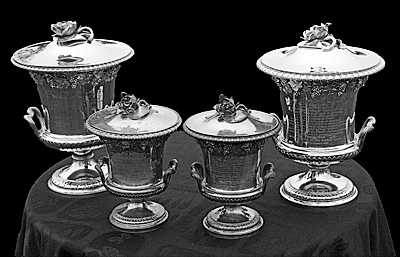
photo by: Simon Lunn The two larger cups are those of Thomas McKay and John Redpath. The two smaller cups are those of Robert Drummond and the partnership of White and Phillips. |
THE GIFT
of Lt Colonel John By
Commanding Royal Engineer
OF THE RIDEAU CANAL, IN UPPER CANADA.
To MESSRS MACKAY and REDPATH
The contractors for the first eight locks
at the entrance from the Ottawa:
two locks at Hartwells, two locks at Hogsback
and four locks and a Dam, sixty five feet in height, at Jones Falls.
AS AN ACKNOWLEDGEMENT of the ZEAL displayed by them
in the performance of their contracts.
and a TESTIMONIAL of the WORKS abovementioned
having been executed to his complete satisfaction:
PRESENTED
ON THE OPENING OF THE RIDEAU CANAL
the 21st of August, 1831
|
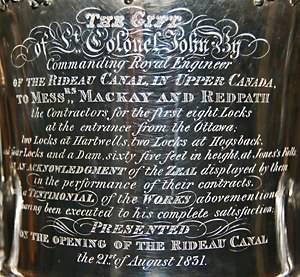
photo by: Simon Lunn |
The exact writing on the cups awarded to McKay and Redpath is shown above. The text on the other cups is similar, the one to Phillips and White for their work on the lock and dam at Black Rapids and the three locks, dam and waste weir at Long Island; the one to Robert Drummond for the four locks, dam and waste weir at Kingston Mills, one lock, dam and waste weir at Brewers Mills and one lock, dam and waste weir at Davis’ Mill.
The official opening was to take place in Bytown, where everyone would board a steamship and make their way through the newly completed locks to Burritts Rapids. It would be a great day, a grand celebration.
However, as the day of the big celebration drew close, a problem developed. The water in the northern section of the Rideau suddenly dropped below navigation level. There wasn’t going to be any grand cruise through this completed section of the canal. Word quickly came to Colonel By that the problem with the water levels was due to one of the millers located upstream, a certain William Mirick.
When Colonel By and his surveyors arrived at the location of Merrick’s Mills in 1826, they found a thriving milling business, operated by William Mirick. Similar to all sections of the canal, By’s first preference was the bypass the existing mills, allowing these operations to continue uninterrupted. This wasn’t always possible. He had to buy out the millers in some locations, but at Merrick’s Mills he came up with a plan that allowed the canal to be constructed with no interference to the existing mills.
By’s original plan was to put the three locks slated for this spot in a “snie,” a flood channel that bypassed the mills, which were located in the main channel of the Rideau River. Mirick was using this flood channel as a by-wash, a water bypass for his mills. After By’s first experience with spring flooding on the Rideau, he realized that his initial plan wouldn’t work. If he blocked Mirick’s by-wash, there was the potential that Mirick’s mills could be flooded. So, he opted for a new plan, to put the locks in a canal cut that bypassed both the mills and the by-wash, leaving them completely intact. Colonel By placed his water control weir adjacent to the head of the canal cut. This provided a navigation depth of water into the canal cut, while allowing most of the natural flow of the Rideau River to continue on to Mirick’s mills.
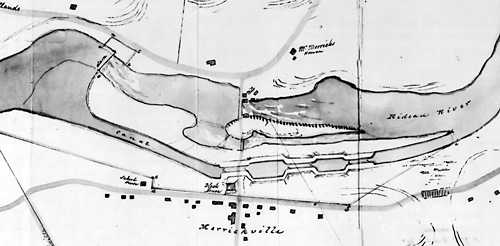 |
| This 1830s map (looking west) shows the configuration at Merrickville shortly after the locks were completed. On the left is the entrance to the canal cut and above that, the canal weir (water control dam). In the centre, above the locks and basins, in the original channel of the Rideau River, are Mirick's mills. Just below that is the Merrick's Snie, the bypass channel. "Plan of the Works at Merrickville", by ?, n.d., Library and Archives Canada, NMC 40978. |
One assumes that William Mirick must have been well aware of By’s plans for the big opening of the northern section of the canal. However, William appears to have been a man insensitive to anything but his own needs. And he needed to make repairs to his dam and mills. So, taking advantage of the low August water flow of the river, he built a cofferdam and effectively shut off the Rideau River.
While we can assume that when Colonel By heard what Mirick had done, his normally ruddy complexion would have been more of a beet shade of red, and that some choice words would have been directed towards William Mirick, the letter Colonel By wrote to his superiors on August 19, 1831 was a model of restraint:
“I have the honor to report that after exerting myself with the hope of opening the Rideau Canal on the 21st Instant from By Town to Burrits and having every thing ready to pass Steam Boats, I find the Navigation impeded by the supply of water being cut off by Mr. Merrick having dammed up the river, to enable him to perform repairs at his Mill etc.; I therefore respectfully beg to observe that if individuals are allowed to Control the waters of the Rideau Canal, the great expenditure that has already taken place will be rendered of little value; consequently it appears indispensably necessary that Mr. Merrick should be written to on this subject and that law Officers of the Crown should be authorized to take such steps as will effectually prevent such interruptions in future, waiting your instructions … "
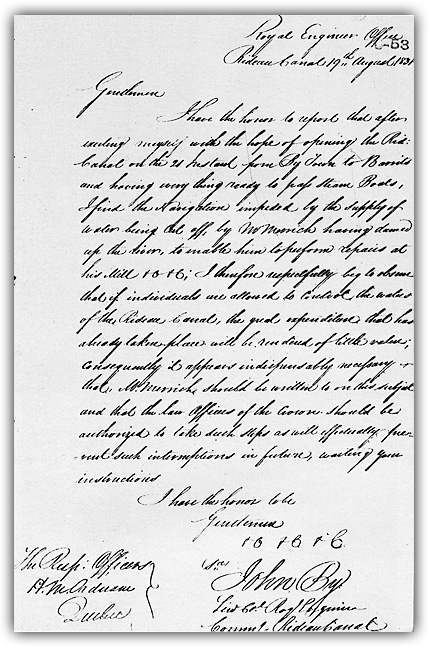 |
Colonel By's Letter of August 19, 1831
Library and Archives Canada, RG8, vol. 53, p.38
|
The history books are silent on whether any cup celebrations took place. We know that Colonel By presented Robert Drummond with his cup at Drummond’s home in Kingston, a quieter affair than the planned grand celebration.
By’s problems with William Mirick foreshadowed the decades-long battles over the use of the water of the Rideau Canal for navigation and its use for powering mills (see Problems and Conflicts).
Mirick’s mills thrived and the whole of the Rideau Canal was officially opened in May 1832 (see the tale “Bye By” for part of the opening voyage).

Sources:
"Construction History of the Rideau Canal," by Karen Price, Manuscript Report 193, Parks Canada, Ottawa, 1976.
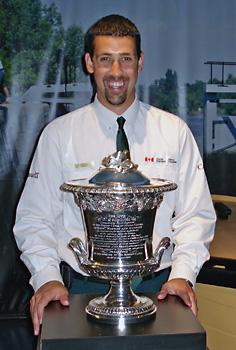
photo by: Simon Lunn |
| The size of the cups awarded to McKay and Redpath is evident in this photo of one of the cups in front of 6 foot, 6 inch (2 m) Parks Canada employee, Mark Brus. |
|